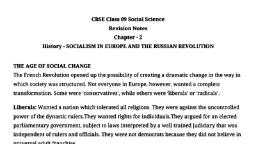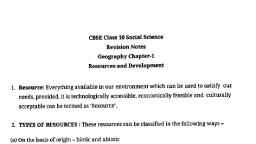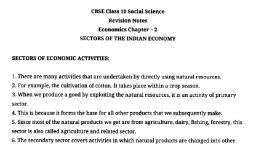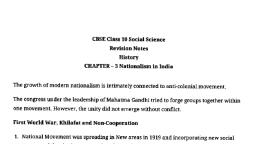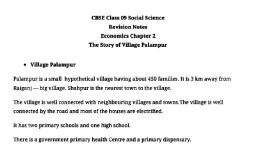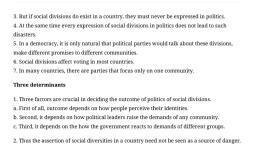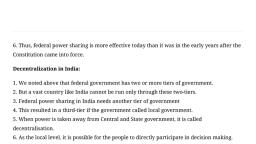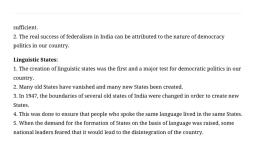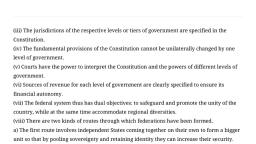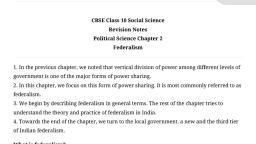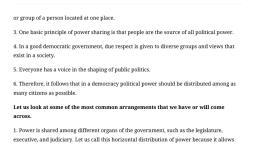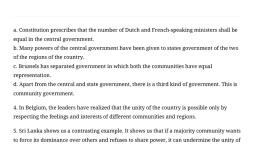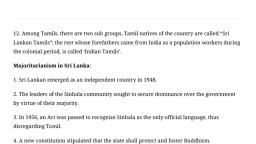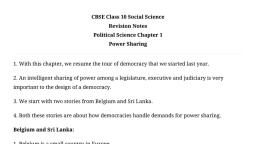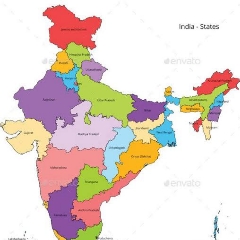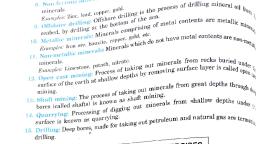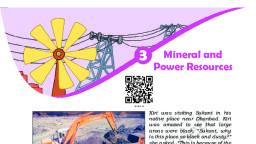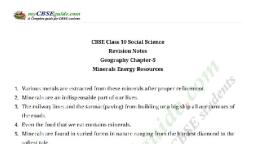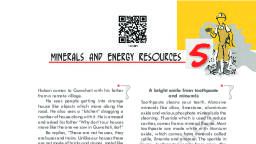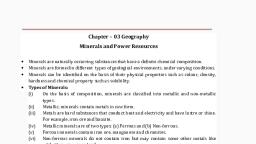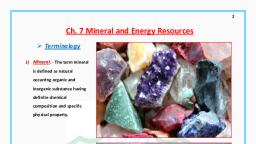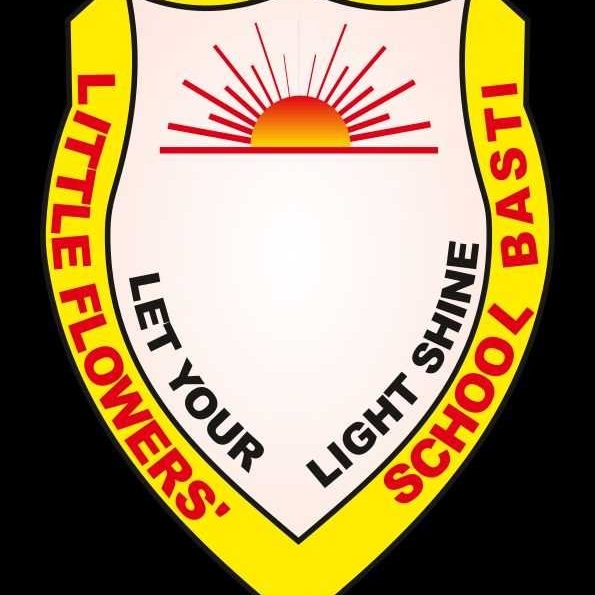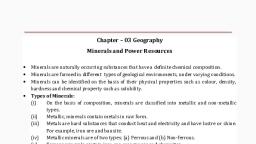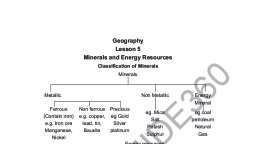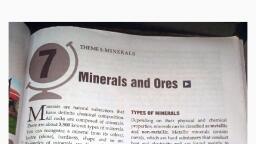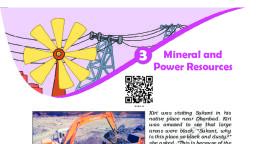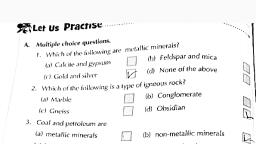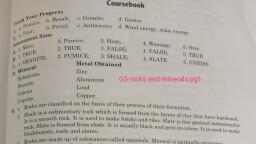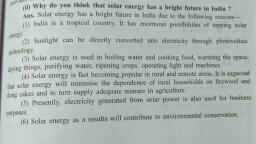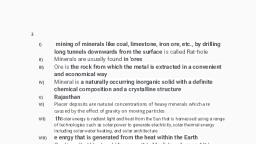Page 1 :
CBSE Class 10 Social Science, , Revision Notes, , Geography Chapter-5, Minerals Energy Resources, , 1. Various metals are extracted from these minerals after proper refinement., 2. Minerals are an indispensable part of our lives., 3. The railway lines and the tarmac(paving) from building or a big ship all are tarmacs of, , the roads., 4. Even the food that we eat contains minerals., 5. Minerals are found in varied forms in nature ranging from the hardest diamond to the, softest talc., , 6. Rock are combinations of homogeneous substances called minerals., 7. Over 2000 minerals have been identified only a few are abundantly found in most of the, rocks., 8. Geologists use these properties to classify the minerals., , Mode of Occurrence of Minerals:, Minerals are usually found in "ores". The term ore is used to describe an accumulation of, any minerals mixed with other elements., , This also determines the cost of understanding the main types of formations in which the, main types of formations in which occur., i In igneous and metamorphic rocks minerals may occur in the cracks crevices faults or, join the smaller occurrences are called Veins and the larger are called Lodes., , i, , In sedimentary rocks a number of minerals occur in beds or layers They have been, formed as a result of deposition accumulation and concentration in horizontal strata., , ii. Another mode of formation involves the decomposition of surface rocks and the removal, of soluble constituents leaving a residual mass of weathered material containing ores., iv. Certain minerals may occur as alluvial deposits in sands of valley floors and the base of, hils., , v. The ocean waters contain vast quantities of minerals to be of economic signification, Common salt, Magnesium and water. The ocean beds, to0 are rich manganese nodules.
Page 2 :
Ferrous Minerals:, , Ferrous minerals account for about three-fourths of the total value of the production of, metallic minerals., , Iron Ore:, , 1. Iron ore is the basic minerals and the backbone of industrial development, 2. The finest iron ore with a very high content of iron up to 70 percent., , 3. In the adjoining Singbhum districts of Jharkhand, haematite iron ore is mined in GUA, , and Noamundi., 4. Durg-Bastar - Chandrapur belt lies in Chhattisgarh and Maharashtra. Very high-grade, hematites are found in the Bastar district of Chattisgarh., 5. The Kudermukh mines located on the western ghats of Karnataka deposits are known to, , be one of the largest in the world, 6. Maharashtra - Goa belt includes the state of gos and Ratnagri istrict of Maharshtra., , 7. Iron ore is exported through Marmago port., , Manganese:, Manganese is mainly used in the manufacturing of steel and ferro - manganese alloy. Nearly, , 10 kg of manganese is required to manufacture bleaching powder and paint., Non-Ferrous Minerals:, India's reserves and production of non - ferrous minerals is not very satisfactory., , Copper:, India is critically deficient in the reserve and production of copper. Being malleable, ductile, and a good conducter, copper is mainly used in electrical cables, electrons and chemical, , industries., Bauxite:, 1. Several ores contain aluminum it is formed bauxite a clay - like substance that alumina, , and later aluminum is obtained., , 2. Bauxite deposits are formed by the decomposition of a wide variety of rocks rich in, aluminum silicates., 3. India's bauxite deposit is mainly found in the Amarkanatk plateau.
Page 3 :
4. Orissa is the largest bauxite producing state in India with 34.97 per cent of the country's, total production in 2000-01., , Non -Metalic Minerals:, 1. Mica is a mineral made up of a series of plates or leaves. It splits easily into thin sheets., 2. Mica, , can, , be clear, black, green, red, , yellow or brown., , 3. Mica is one of the most indispensable minerals used in electric and electrons industries., 4. Mica deposits are found in the northern edge of the Chota Nagpur Plateau, Koderma Gaya, , - Hazaribagh belt of Jharkhand is the leading producer., 5. In Rajasthan, the major mica producing area is around Ajmer., , Rock Minerals:, Limestone is found in association with composed of calcium carbonates or calcium and, magnesium carbonates., Conservation Of Minerals:, , 1. The strong dependence of industry and agriculture upon mineral deposits and the, , substances manufactured from them., 2. The total volume of workable mineral deposits is an insignificant fraction., , 3. The rates of replenishment are infinitely small in comparison., 4. A concerted effort to be made in order to use mineral resources in a planned and, , sustainable manner., Energy Resources:, , 1. Energy is required for all activities, It is needed to cook to provide light and heat to, , propel., 2., , Energy can be generated from fuel minerals like coal, petroleum, , from fuel mineral like, , coal, petroleum, natural gas, uranium and from electricity., 3. It consumes most valuable manure which could be used in agriculture., , Conservation Sources of Energy:, Coal:, 1. The most, , abundantly available fossil fuel., , It, , provides a, , substantial part of the nation's
Page 4 :
energy needs., , 2. Lignite is a low-grade brown coal which is soft with high moisture content., 3. Anthracite is the highest quality hard coal., , 4. A little over 200 million years in age and in tertiary deposits which are only about 55, million years old., , Petroleum:, , 1. Petroleum or mineral oil is the next major energy source in India after coal., 2. Petroleum refineries act as a "nodal industry" for synthetic textile, fertile and numerous, chemical industries., , 3. The oil is prevented from rising or sinking by intervening non -porous layer., About 63 per cent of India's petroleum production is from Mumbai High. 18 per cent from, 4. the, map locates the 3 major off shore field of western India., Natural Gas:, , 1. Natural gas is an important clean energy resource found in association with or without, petroleum., , 2. It is used as a source of energy as well as an industrial raw material in the petrochemical, , industry., 3. The fuel for the present century., , 4. Andaman and Nicobar are land are also important areas having large reserves of natural, gas., , 5. The 1700 km long Hazira -Vijaipur Jagdishpur cross country gas pipeline links Mumbai, High and Bassien with the fertilizer power and industrial complexes in western and, northern India., , 6. The power and fertilizer industries are the key users of natural gas., , Electricity:, 1. Electricity has such a wide range of application in today's world that its per capita, consumption is considered as an index of development., 2. Electricity is generated mainly in two ways by running water., , 3. Burning of fuels sucha coal petroleum gas to drive turbines to produce thermal power., 4. Hydro electricity is generated by fast flowing water.
Page 5 :
5, Thermal electricity is generated by using coal, petroleum and natural gas, 6. There are over 310 thermal power plants in India., , Non-Conventional Sources of Energy:, 1. The growing consumption of energy has resulted in the country becoming increasingly, , dependent on fossil fuel such as coal oil and gas, 2. There is a pressing need to use renewable energy sources like solar energy, wind, tide,, biomass and energy from waste material., 3. These are called non - conventional energy sources., 4. These are called non - conventional energy sources., , Nuclear or Atomic Energy:, 1. It is obtained by altering the structure of atoms., , 2. The form of heat and this is used to generated electric power., 3. The Aravalli ranges of Rajasthan are used for generating atomic or nuclear power., 4. The Monazite sands of Kerala is also rich in Thorium., , Solar Energy:, 1. India is a tropical country. It has enormous possibilities of tapping energy., , 2. Photovoltaic technology converts sunlight directly into electricity., 3. In turn will contribute to environmental conservation and adequate supply of manure in, agriculture, , Wind Power:, 1. India now ranks as a "wind super power" the world., to Madurai., largest wind farm cluster is located in Tamil Nadu from Nagercoil, in the, of, Nagercoil and Jaisalmer are well known for the effective use wind energy, , 2. The, 3., , country., , Biogas:, 1., , Shrubs, farm waste, animal and human waste, , consumption, 2. The, , I rural, , are, , used, , to, , produce biogas for domestic, , areas., , plant using cattle dung are know a, , 'Gobar gas, , plant', , in rural India.
Page 6 :
3. It improves the loss of trees and manure due to the burning of fuel wood and cow dung, , cakes., , Tidal Energy:, 1. Oceanic tides can be used to generate electricity. Floodgate dams are built across, , intellect., 2. The sea via a pipe that carries it through a power generating turbine., 3. A 900 Mw tidal energy power plant is setup here by the National Hydropower, , Corporation., Geo Thermal Energy:, 1. Geothermal energy refers to the heat and electricity produced by heat from the interior, of the earth., , 2. It is so hot that when it rises to the earth's surface it turns into steam., 3. This stem is used to drive turbines and generate electricity., Conservation of Energy Resources:, , 1. Energy is a basic requirement for economic development., 2. The economic development plans implemented since Independence necessarily required, increasing amounts of energy to remain operational., 3. Promotion of energy conservation and increased use of renewable energy sources are the, twin planks of sustainable energy., 4. India is presently one of the least energy efficient countries I the world, , 5. Energy saved is energy produced.


